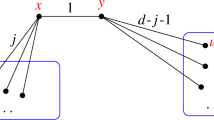Abstract
Construction of nested balanced incomplete block (BIB) designs, nested balanced ternary designs and rectangular designs from given nested BIB designs and resolvable BIB designs are described. New constructions ofq-ary codes from nested BIB designs and balanced bipartite weighing designs are also given.
Similar content being viewed by others
References
C.T. Chang and K. Hinkelmann, A series of EGD PBIB designs, J. Stat. Planning Infer.16 (1987) 1–13.
A. Dey, Theory of block designs, Wiley Eastern Ltd., New Delhi, 1986
A. Dey, U.S. Das, and A.K. Banarjee, On nested balanced block designs, Cal. Stat. Ass. Bull.35 (1986) 161–167.
K. Hinkelmann, Extended group divisible partially balanced incomplete block designs, Ann. Math. Stat.35 (1964) 681–695.
C. Huang, Balanced bipartite weighing designs, J. Combin. Theory, Ser. A21 (1976) 20–34.
S. Kageyarna, A survey of resolvable solutions of BIB designs, Int. Stat. Rev.40 (1972) 269–273.
C. MacKenzi and J. Scherry, Maximalq-ary codes and Plotkin's bound, ATS Combinations, Ars Combinatoria26 (1988) 37–50.
Y. Miao, and S. Kageyama, Two classes of q-ary codes based on group divisible association schemes, In: 3rd Triennial Calcutta Symposium on Prob. and Stat., Calcutta University, Calcutta, 1997.
J.P. Morgan, Nested Designs, Handbook of Statistics, Vol. 13 Elsevier Press, New York, 1996, pp. 939–954.
D.A. Preece, Nested balanced incomplete block designs, Biometrika54 (1967) 479–486.
N.V. Semakov and A.A. Zinoviev, Equidistantq-ary codes with maximal distance and resolvable balanced incomplete block designs, Problemi Peredatchi Informatsii4 (1968) 3–10.
K. Sinha, A construction of rectangular designs, J. Combin. Math. and Combin. Comput.9 (1991) 199–200.
K. Sinha, S. Kageyama, and M.K. Singh, Construction of rectangular designs, Statistics25 (1993) 63–70.
K. Sinha, A class ofq-ary codes, Discrete Math.126 (1994) 439–440.
K. Sinha, R.K. Mitra, and G.M. Saha, Nested NIB designs, balanced bipartite weighing designs and rectangular designs, Utilitas Mathematica49 (1996) 216–222.
D.R. Stinson and G.H.J. van Rees, The equivalence of certain equidisant binary codes and symmetric BIBDs, Combinatiorica4 (1984) 357–362.
C. Suen, Some recangular designs constructed by the method of differences, J. Stat. Plann. Infer.21 (1989) 273–276.
V.D. Tonchev, Combinatorial Configurations: Designs, Codes, Graphs, John Wiley & Sons, 1989.
Author information
Authors and Affiliations
Rights and permissions
About this article
Cite this article
Sinha, K., Mitra, R.K. Construction of nested balanced block designs, rectangular designs andq-ary codes. Annals of Combinatorics 3, 71–80 (1999). https://doi.org/10.1007/BF01609877
Received:
Issue Date:
DOI: https://doi.org/10.1007/BF01609877



